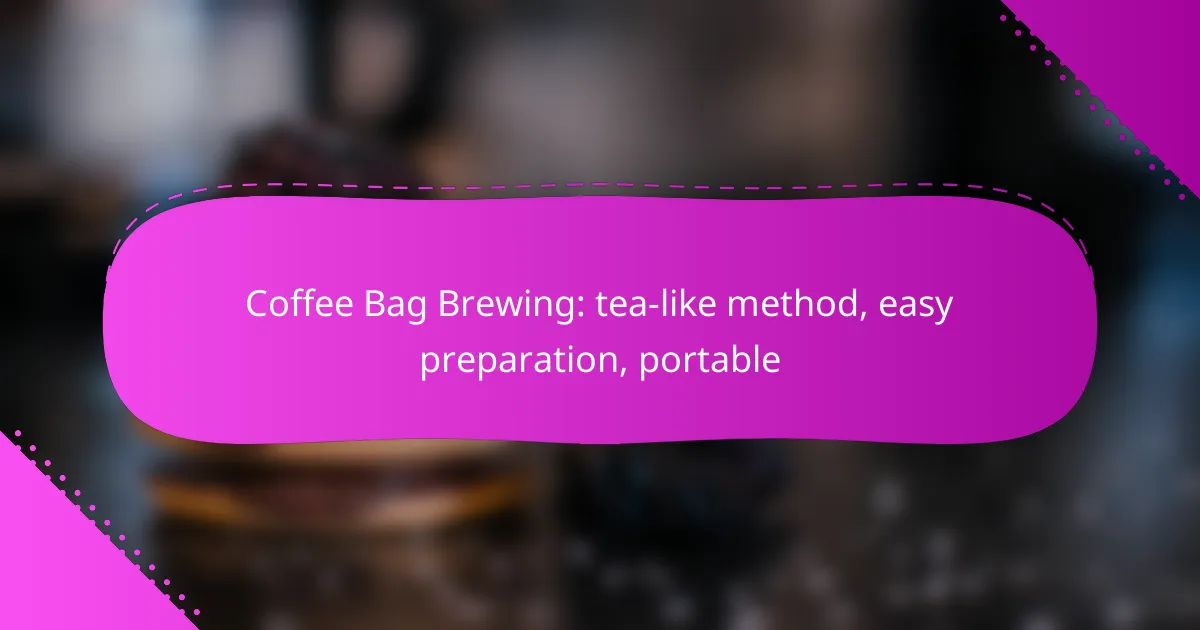Brewing coffee bags like tea is a straightforward and convenient method that allows you to savor a rich cup of coffee without the hassle of traditional brewing equipment. This technique is especially popular in New Zealand, where its easy preparation and portability make it perfect for both home use and outdoor adventures.

How to brew coffee bags like tea in New Zealand?
Brewing coffee bags like tea is a simple and convenient method that allows you to enjoy a flavorful cup of coffee without the need for complex equipment. In New Zealand, this technique is gaining popularity due to its ease of preparation and portability, making it ideal for both home and outdoor settings.
Use hot water infusion
To brew coffee bags like tea, start by using hot water infusion. Boil water to around 90-95 degrees Celsius, which is suitable for extracting flavors without burning the coffee. Pour the hot water over the coffee bag in your cup or a portable brewing device.
Ensure that the coffee bag is fully submerged in the water to allow for even extraction. This method mimics traditional tea brewing and helps to release the coffee’s aromatic compounds effectively.
Steep for optimal flavor
Steeping time is crucial for achieving the best flavor when brewing coffee bags. Aim for a steeping duration of about 4-6 minutes, depending on your taste preference. A longer steep can lead to a stronger, more robust flavor, while a shorter steep will yield a milder cup.
Be mindful not to steep for too long, as this can result in bitterness. Experiment with different steeping times to find the perfect balance that suits your palate. Enjoy your freshly brewed coffee bag beverage at home or take it on the go for a quick caffeine fix.
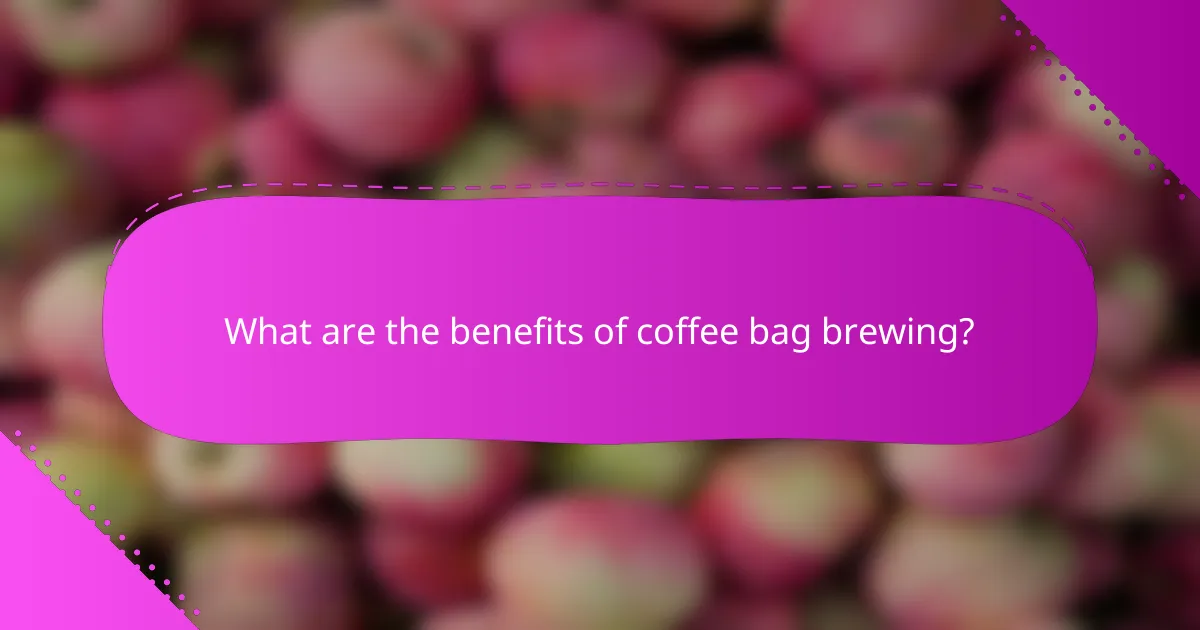
What are the benefits of coffee bag brewing?
Coffee bag brewing offers a simple and efficient way to enjoy coffee, similar to brewing tea. This method provides convenience and ease, making it a popular choice for those seeking a quick and mess-free coffee experience.
Convenient preparation
Preparing coffee using bags is straightforward and requires minimal equipment. Simply boil water, steep the coffee bag in it for a few minutes, and your drink is ready. This method eliminates the need for coffee grounds, filters, or complex brewing devices.
For best results, use water just off the boil and steep for about 4-5 minutes. Adjust the steeping time based on your taste preference; longer steeping can yield a stronger flavor. This simplicity makes coffee bag brewing ideal for busy mornings or quick breaks.
Portable for travel
Coffee bags are an excellent choice for travel due to their lightweight and compact nature. They can easily fit in a backpack or suitcase, allowing you to enjoy fresh coffee anywhere, from hotels to campsites.
To brew on the go, all you need is hot water, which can be obtained from a kettle or even a portable coffee maker. This portability means you can enjoy your favorite coffee without relying on local cafes or instant options, making it a great solution for travelers and outdoor enthusiasts alike.
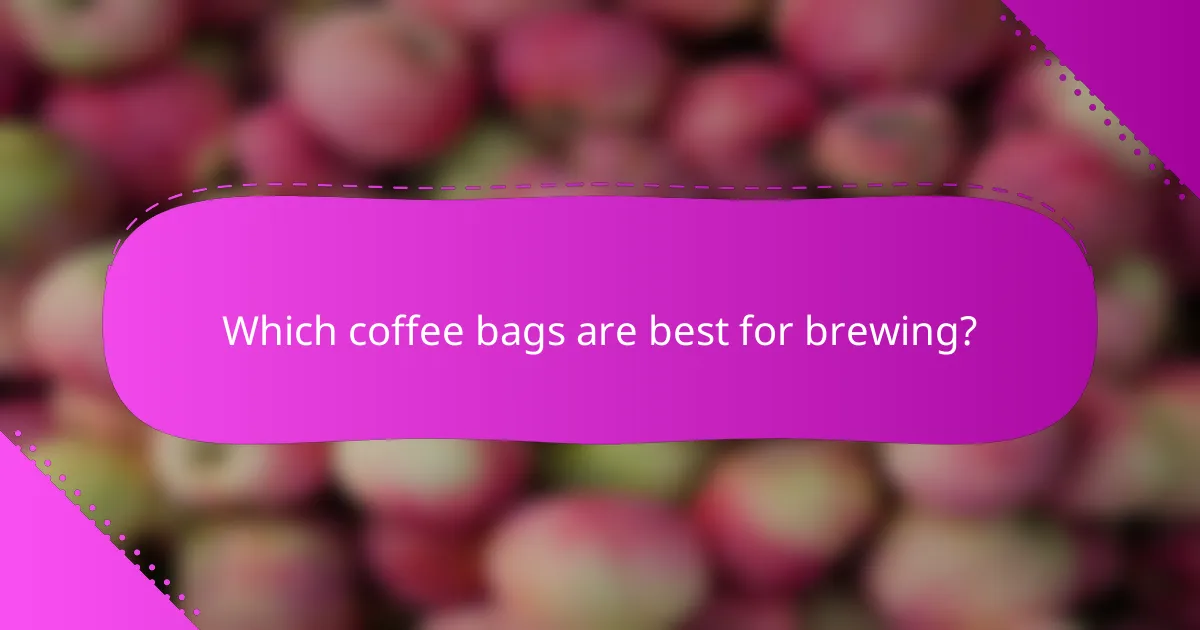
Which coffee bags are best for brewing?
The best coffee bags for brewing depend on personal taste preferences and desired flavor profiles. Single-origin coffee bags offer distinct flavors from specific regions, while flavored coffee bags provide a variety of added tastes for a unique experience.
Single-origin coffee bags
Single-origin coffee bags are sourced from a specific region or farm, allowing for unique flavor characteristics that reflect their origin. These bags often highlight the terroir, which can include notes of fruit, chocolate, or floral undertones.
When choosing single-origin coffee bags, consider the roast level and the region’s typical flavor profile. For example, Ethiopian coffees are often fruity and bright, while Colombian varieties tend to be well-balanced with nutty flavors. Experimenting with different origins can enhance your brewing experience.
Flavored coffee bags
Flavored coffee bags are infused with various flavors, such as vanilla, hazelnut, or caramel, providing a sweet and aromatic twist to your brew. These bags are ideal for those who enjoy a more dessert-like coffee experience.
When selecting flavored coffee bags, check the ingredient list for natural versus artificial flavorings. Natural flavors tend to offer a more authentic taste, while artificial options may be more intense. It’s also wise to consider the balance of flavor; a good flavored coffee should complement rather than overpower the coffee’s natural taste.
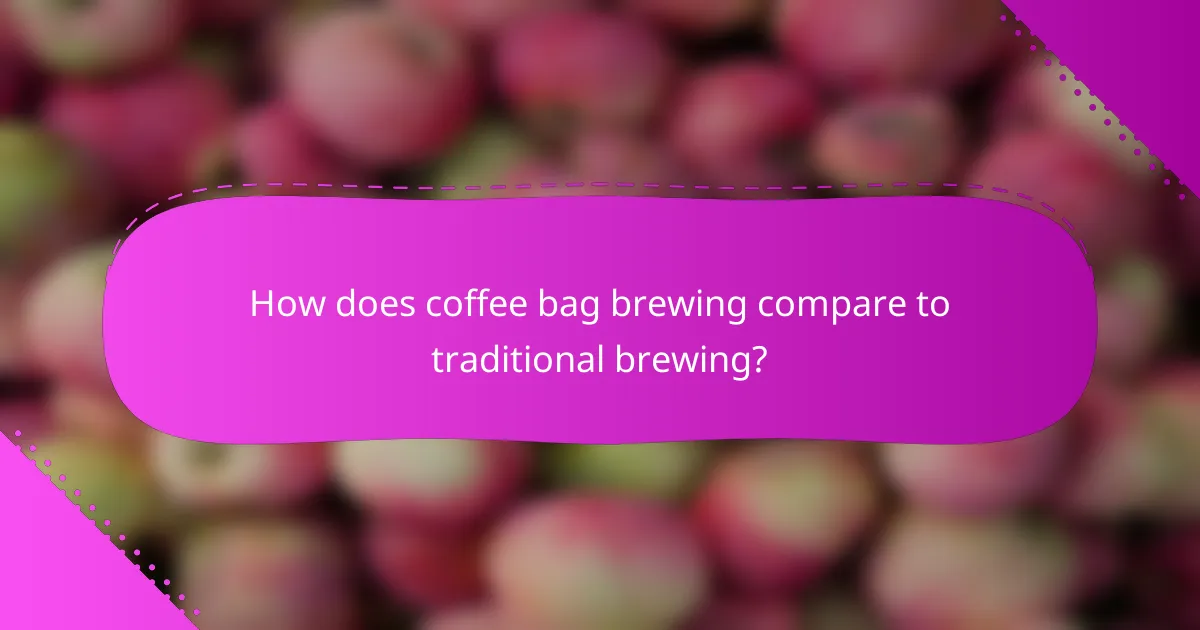
How does coffee bag brewing compare to traditional brewing?
Coffee bag brewing offers a convenient and efficient alternative to traditional brewing methods. It simplifies the process by allowing users to steep coffee in a bag, similar to tea, which can result in a quicker and less complicated experience.
Faster brewing time
Coffee bag brewing typically takes just a few minutes, often around 3 to 5 minutes, compared to traditional methods that can require more time for preparation and brewing. This speed makes it ideal for those with busy schedules or when a quick caffeine fix is needed.
The quick brewing time is largely due to the pre-measured coffee grounds in the bag, which eliminates the need for grinding and measuring. Simply steep the bag in hot water, and your coffee is ready to enjoy.
Less equipment needed
One of the main advantages of coffee bag brewing is that it requires minimal equipment. Unlike traditional brewing methods that often need coffee makers, grinders, and filters, all you need is hot water and a cup.
This portability makes coffee bag brewing perfect for travel, camping, or even office use, as you can easily pack a few bags without taking up much space. Just ensure you have access to hot water, and you can enjoy fresh coffee anywhere.
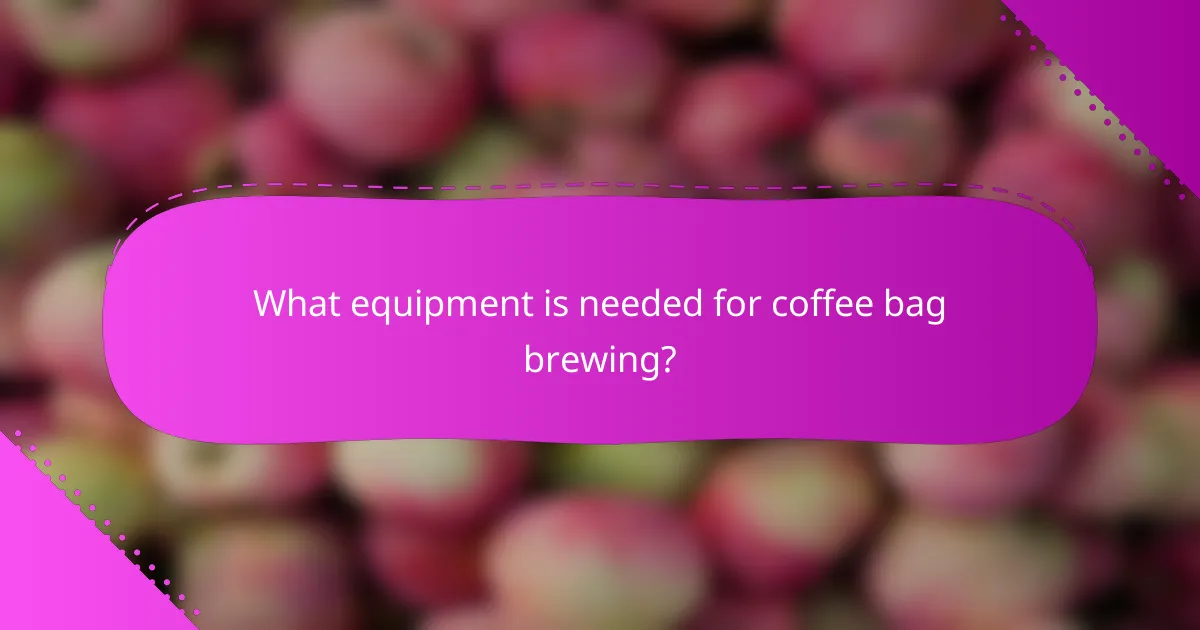
What equipment is needed for coffee bag brewing?
To brew coffee using the coffee bag method, you need a few essential items that simplify the process and enhance portability. The primary requirements include a hot water source and a brewing vessel, both of which can be easily sourced or carried for on-the-go brewing.
Hot water source
A reliable hot water source is crucial for coffee bag brewing. This can range from an electric kettle to a portable camping stove, or even a simple thermos filled with hot water. Ensure the water temperature is around 90-96°C (195-205°F) for optimal extraction.
When selecting a hot water source, consider factors like heating speed and portability. For instance, a compact electric kettle is ideal for home use, while a lightweight camping stove is perfect for outdoor adventures.
Brewing vessel
The brewing vessel is where the coffee bag will steep in hot water. Options include a mug, a travel tumbler, or a dedicated coffee dripper. Choose a vessel that can comfortably hold the volume of water you plan to use, typically between 240-350 ml (8-12 oz).
For best results, ensure your brewing vessel is clean and made from materials that retain heat well, such as ceramic or stainless steel. Avoid plastic containers, as they may not withstand high temperatures and can affect the flavor of the coffee.
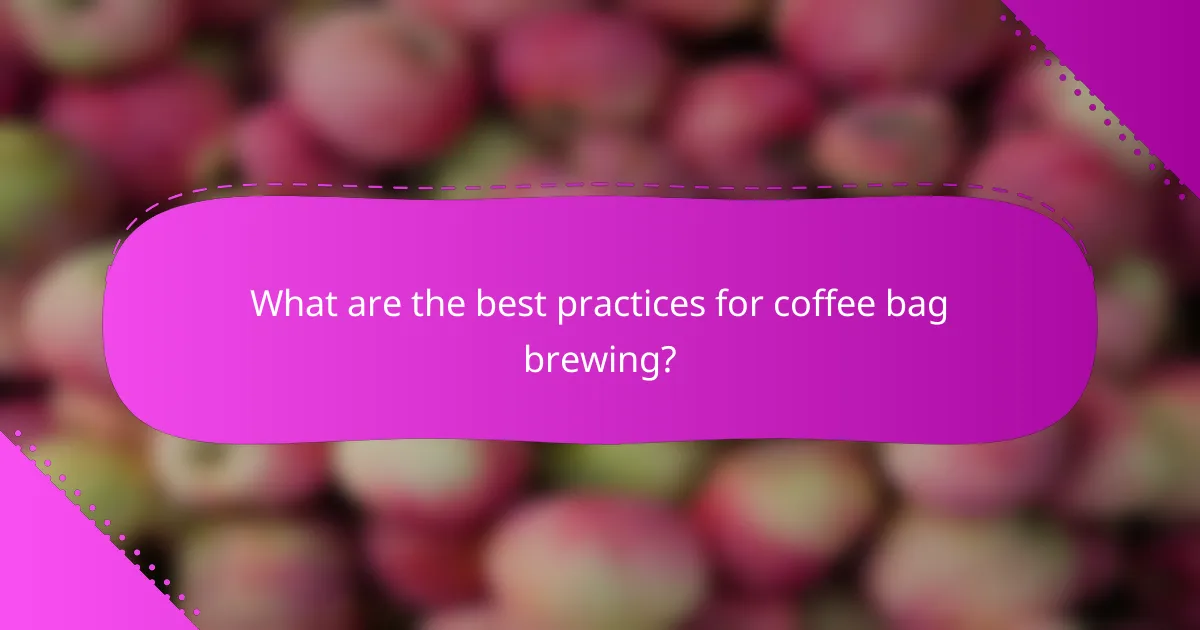
What are the best practices for coffee bag brewing?
To achieve the best results with coffee bag brewing, focus on using the correct water temperature and steeping time. These factors significantly influence the flavor and strength of your coffee, ensuring a satisfying brew.
Correct water temperature
The ideal water temperature for brewing coffee bags typically ranges from 90°C to 96°C (194°F to 205°F). Using water that is too hot can lead to over-extraction, resulting in a bitter taste, while water that is too cool may under-extract, leaving the coffee weak and flavorless.
A simple way to achieve the right temperature is to bring water to a boil and then let it sit for about 30 seconds before pouring it over the coffee bag. This method helps to avoid extremes and allows for a balanced extraction.
Proper steeping time
Steeping time is crucial for coffee bag brewing, with a recommended range of 4 to 6 minutes. This duration allows the coffee grounds to release their flavors fully without becoming overly bitter. Adjusting the steeping time can help you customize the strength of your brew.
For a milder flavor, aim for the lower end of the range, while a stronger cup can be achieved by steeping closer to 6 minutes. Keep in mind that steeping for too long can lead to undesirable bitterness, so it’s best to monitor the time closely.

How to choose the right coffee bag for your taste?
Selecting the right coffee bag involves understanding your flavor preferences and the brewing method. Look for bags that highlight specific flavor notes and roast levels to ensure a satisfying cup.
Flavor profiles
Flavor profiles in coffee bags can range from fruity and floral to nutty and chocolatey. When choosing, consider what flavors you enjoy most; for instance, if you prefer a bright taste, look for bags labeled with citrus or berry notes.
Many coffee bags will describe their flavor profiles on the packaging, making it easier to find what suits your palate. Experimenting with different profiles can enhance your coffee experience and help you discover new favorites.
Roast levels
Roast levels significantly impact the taste of your coffee. Light roasts tend to be more acidic and retain more of the bean’s original flavors, while dark roasts offer a bolder, richer taste with less acidity.
When selecting a coffee bag, consider your preference for roast levels. If you’re unsure, starting with a medium roast can provide a balanced flavor that appeals to a wide range of tastes. Always check the roast date to ensure freshness, as coffee is best enjoyed shortly after roasting.

What are common mistakes in coffee bag brewing?
Common mistakes in coffee bag brewing include using the wrong water temperature, not allowing enough steeping time, and over-extraction. These errors can lead to a bitter or weak flavor profile, detracting from the overall experience.
Using incorrect water temperature
Water temperature plays a crucial role in coffee extraction. Ideally, the water should be between 90°C and 96°C (194°F to 205°F) for optimal brewing. Using water that is too hot can scorch the coffee, while cooler water may result in under-extraction, leading to a bland taste.
Insufficient steeping time
Steeping time significantly affects the flavor of coffee brewed in a bag. A typical steeping duration ranges from 4 to 6 minutes. If you remove the bag too early, the coffee may taste weak; leaving it too long can result in bitterness.
Over-extraction
Over-extraction occurs when coffee grounds are exposed to water for too long, releasing undesirable flavors. To avoid this, monitor both the steeping time and the grind size of the coffee. A coarser grind can help prevent over-extraction, especially when using a coffee bag method.
